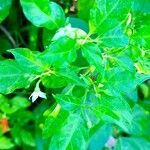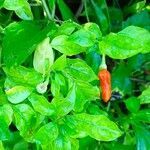Small shrub, herbaceous or quite woody to 2 m tall, glabrous to pubescent, mostly fine-puberulent. Flowers, above the first node, more than one to a node; pedicels mostly thickening and erect in fruit; calyx cyathiform-to almost tubular, truncate or with small, deltoid umbos, lacking a constriction at the base near the pedicel; the corolla white or greenish, the lobes spreading to recurved; the anthers blue to violet, rarely yellow; the style exserted 1.5 mm or more beyond the anthers. Mature fruit erect, deciduous, soft fleshed, of various shape, mostly red.
Herb or shrub to 2 m high. Leaves ovate to ovate-lanceolate; lamina up to 10 cm long, 5 cm wide, frequently smaller; petiole usually 1–3 cm long. Flowers usually several in each leaf axil. Pedicels 10–20 mm long. Calyx 2–3 mm long. Corolla c. 8 mm diam., white or green. Staminal filaments 1 mm long; anthers 1.5–2 mm long, usually blue. Ovary obtusely conical, 1.5–2 mm long; style 3–4 mm long. Berry erect, narrowly conical to narrowly ellipsoid or fusiform, 10–20 mm long, 3–7 mm diam., red; fruiting pedicel 15–25 mm long. Seeds 3–5 mm long, yellow.
Leaves usually solitary, rarely 2 appearing together; petiole 0.3–3 cm long; lamina membranous or papyraceous, 1.5>i>–15 × 0.7>i>–6 cm, lanceolate to broadly ovate or elliptic, base rounded to attenuate, and often unequal-sided, apex obtusely acuminate to obtuse, ± entire, ciliate, with scattered hairs, sometimes only along the nerves above, paler, duller, with a few hairs in the axils of the nerves beneath.
It is a shrubby perennial plant about 1 m tall. The leaves are smaller than round capsicums or bell peppers. Two or more flowers occur together in the axils of leaves. They have small pointed fruit about 1-2 cm long and they are red when ripe. They have a very hot taste when eaten or touched on the lips.
Corolla white or yellowish to greenish, rarely purplish, often with yellow markings in the throat, rotate-campanulate; limb 6>i>–10 mm across; lobes 1.5>i>–4 mm long, ovate-triangular, acute, ± ciliolate, spreading or reflexed.
Calyx ± rugose, 1.5>i>–2.5 mm long, cupular or sub-tubular, 5-or 10-ribbed, truncate or with short, obtuse teeth or deltate umbos, glabrous or slightly pubescent; in fruit enlarged and surrounding the base of it.
Fruit erect from the nodes, green, becoming orangish or red when mature, glossy, 0.9>i>–2 × 0.4>i>–0.6 cm, ovoid-oblong or irregularly fusiform, obtusely pointed, smooth, glabrous, very pungent or acrid, edible.
Flowers 2>i>–3(4)-whorled, rarely solitary; pedicels 10>i>–20 mm long, ± terete, striate, slender, thickened upwards, glabrous, ± erect or curved distally, in fruit elongated to 30 mm and slender.
Ovary 1–1.8 mm long, ± ovoid or ellipsoid, rounded or tapering, glabrous, 2-locular; style 3.4–5 mm long, straight, not or slightly thickened distally into a small stigma.
Branches often quite woody, terete or slightly angular, ± striate or somewhat channelled, glossy, pubescent when young to ± glabrous.
Filaments 1–2 mm long; anthers blue to purple, rarely yellow, 1.5–2.2 mm long, oblong or oblong-ovate in outline.
Seeds brownish, 3.2>i>–3.7 × 2.5>i>–3 mm, obovate to sub-circular in outline.
Erect or spreading, ± bushy, short-lived perennial, up to 2 m tall.
Undershrub 2-3 ft. high, much-branched, angular
Flowers white or pale yellow.
Nearly glabrous stems





